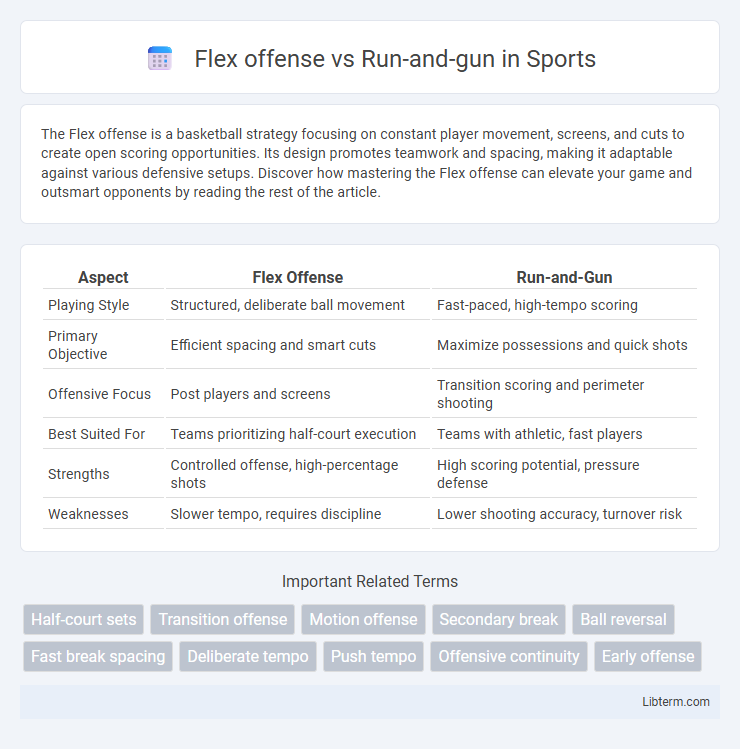The Flex offense is a basketball strategy focusing on constant player movement, screens, and cuts to create open scoring opportunities. Its design promotes teamwork and spacing, making it adaptable against various defensive setups. Discover how mastering the Flex offense can elevate your game and outsmart opponents by reading the rest of the article.
Table of Comparison
| Aspect | Flex Offense | Run-and-Gun |
|---|---|---|
| Playing Style | Structured, deliberate ball movement | Fast-paced, high-tempo scoring |
| Primary Objective | Efficient spacing and smart cuts | Maximize possessions and quick shots |
| Offensive Focus | Post players and screens | Transition scoring and perimeter shooting |
| Best Suited For | Teams prioritizing half-court execution | Teams with athletic, fast players |
| Strengths | Controlled offense, high-percentage shots | High scoring potential, pressure defense |
| Weaknesses | Slower tempo, requires discipline | Lower shooting accuracy, turnover risk |
Introduction to Flex Offense and Run-and-Gun
Flex Offense emphasizes structured spacing and constant motion to create high-percentage scoring opportunities through cuts and screens, promoting teamwork and discipline. Run-and-Gun prioritizes a fast-paced, high-scoring style that focuses on quick transitions, frequent three-point attempts, and exploiting defensive mismatches. Each system offers distinct strategies: Flex Offense thrives on precision and execution, while Run-and-Gun leverages speed and offensive volume.
Key Principles of the Flex Offense
The Flex offense emphasizes continuous motion, precise timing, and teamwork through its patterned cuts, screens, and passes designed to create scoring opportunities. It relies on constant player spacing and flexible positioning, enabling players to read defenses and exploit mismatches effectively. Unlike the fast-paced Run-and-Gun style, the Flex offense prioritizes controlled ball movement and strategic execution to wear down opponents defensively.
Core Concepts of the Run-and-Gun Style
The run-and-gun style emphasizes quick transitions and fast-paced offense, prioritizing rapid ball movement and high shot volume to overwhelm defenses. Its core concepts include relentless pressure on the defense, frequent fast breaks, and a focus on scoring early in the shot clock. This approach contrasts with the Flex offense, which relies on structured cuts, screens, and deliberate ball movement to create high-percentage scoring opportunities.
Historical Evolution of Flex and Run-and-Gun
The Flex offense, pioneered by coach Rene Portland in the 1960s, evolved as a structured system emphasizing spacing, constant motion, and precise passing to exploit defensive weaknesses. Run-and-gun emerged in the 1980s with coaches like Paul Westhead, promoting a fast-paced, high-scoring style prioritizing rapid shots and relentless transition offense. Both offenses transformed basketball strategies, with the Flex influencing disciplined team play and Run-and-gun accelerating game tempo and increasing scoring opportunities.
Strengths of Flex Offense
The Flex offense excels in creating constant motion and misdirection, making it difficult for defenses to predict and contain players. Its structured spacing and cutting patterns enable high-percentage shots and effective use of all five players, promoting team balance and versatility. This system thrives on patience and precision, often resulting in better shot selection compared to the fast-paced, high-risk Run-and-gun style.
Advantages of Run-and-Gun Offense
The Run-and-Gun offense maximizes scoring opportunities by emphasizing a fast tempo and frequent shots, thereby keeping defenses off balance and reducing their ability to set up. Its high pace increases the number of possessions, which often leads to more points and forces opponents into quicker decisions and mistakes. This style also capitalizes on conditioning and depth, enabling teams to exploit mismatches and sustain pressure throughout the game.
Flex Offense: Player Roles and Responsibilities
Flex Offense emphasizes precise spacing and constant player movement, with each athlete rotating through specific roles such as cutters, screeners, and ball handlers to create scoring opportunities. Players are responsible for setting screens, executing cuts, and maintaining floor balance to exploit defensive weaknesses. Unlike Run-and-gun, which prioritizes rapid transitions and high shooting volumes, Flex Offense demands disciplined execution and coordination to facilitate consistent inside-out scoring options.
Run-and-Gun: Suitability for Team Types
Run-and-gun offense suits teams with fast, agile players excelling in quick transitions and high scoring tempo. It maximizes scoring opportunities through rapid ball movement and frequent three-point attempts, ideal for squads with strong shooters and versatile guards. Unlike the structured Flex offense, run-and-gun demands exceptional endurance and defensive switching from players to maintain pace and counter opponent scoring.
Tactical Comparison: Flex vs Run-and-Gun
The Flex offense emphasizes structured player movement, spacing, and continuous screening to create high-percentage shots through disciplined ball movement and teamwork, contrasting with the Run-and-Gun style's fast-paced, high-tempo approach prioritizing quick transitions and frequent three-point attempts. Flex relies on methodical half-court sets that minimize turnovers by promoting patience and precise timing, whereas Run-and-Gun exploits speed and athleticism to generate scoring opportunities before the defense can set up. Defensively, Flex is better suited for controlling game tempo and exploiting mismatches, while Run-and-Gun pressures defenses with relentless pace and rapid shot selection.
Choosing the Right Offense for Your Team
Selecting the right offensive strategy depends on your team's strengths and play style, where the Flex offense emphasizes disciplined spacing and continuous player movement to exploit defensive weaknesses. The Run-and-gun offense prioritizes fast pace and high scoring, relying on quick transitions and aggressive shooting to pressure opponents. Evaluating your roster's skill set, such as speed, shooting accuracy, and decision-making, ensures the chosen offense maximizes scoring opportunities and maintains effective game tempo.
Flex offense Infographic

 libterm.com
libterm.com